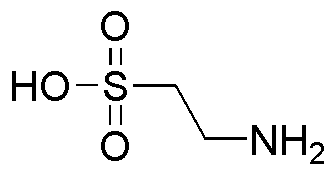2-Aminoethanesulfonic acid is widely utilized in research focused on:
- Biotechnology: This compound serves as a buffering agent in cell culture media, helping to maintain stable pH levels, which is crucial for optimal cell growth and function.
- Pharmaceuticals: It is used in the formulation of various drugs, particularly in enhancing the solubility and stability of active ingredients, making medications more effective.
- Neuroscience: As a key component in neurotransmitter studies, it aids in the investigation of brain functions and the development of treatments for neurological disorders.
- Agriculture: The compound is applied in the formulation of fertilizers and soil amendments, promoting plant growth by improving nutrient uptake and soil health.
- Food Industry: It acts as a food additive, enhancing flavor and stability in various products, thereby improving the overall quality of food items.
General Information
Properties
Safety and Regulations
Applications
2-Aminoethanesulfonic acid is widely utilized in research focused on:
- Biotechnology: This compound serves as a buffering agent in cell culture media, helping to maintain stable pH levels, which is crucial for optimal cell growth and function.
- Pharmaceuticals: It is used in the formulation of various drugs, particularly in enhancing the solubility and stability of active ingredients, making medications more effective.
- Neuroscience: As a key component in neurotransmitter studies, it aids in the investigation of brain functions and the development of treatments for neurological disorders.
- Agriculture: The compound is applied in the formulation of fertilizers and soil amendments, promoting plant growth by improving nutrient uptake and soil health.
- Food Industry: It acts as a food additive, enhancing flavor and stability in various products, thereby improving the overall quality of food items.
Documents
Safety Data Sheets (SDS)
The SDS provides comprehensive safety information on handling, storage, and disposal of the product.
Product Specification (PS)
The PS provides a comprehensive breakdown of the product’s properties, including chemical composition, physical state, purity, and storage requirements. It also details acceptable quality ranges and the product's intended applications.
Certificates of Analysis (COA)
Search for Certificates of Analysis (COA) by entering the products Lot Number. Lot and Batch Numbers can be found on a product’s label following the words ‘Lot’ or ‘Batch’.
Numéro de catalogue
Numéro de lot/série
Certificates Of Origin (COO)
This COO confirms the country where the product was manufactured, and also details the materials and components used in it and whether it is derived from natural, synthetic, or other specific sources. This certificate may be required for customs, trade, and regulatory compliance.
Numéro de catalogue
Numéro de lot/série
Safety Data Sheets (SDS)
The SDS provides comprehensive safety information on handling, storage, and disposal of the product.
DownloadProduct Specification (PS)
The PS provides a comprehensive breakdown of the product’s properties, including chemical composition, physical state, purity, and storage requirements. It also details acceptable quality ranges and the product's intended applications.
DownloadCertificates of Analysis (COA)
Search for Certificates of Analysis (COA) by entering the products Lot Number. Lot and Batch Numbers can be found on a product’s label following the words ‘Lot’ or ‘Batch’.
Numéro de catalogue
Numéro de lot/série
Certificates Of Origin (COO)
This COO confirms the country where the product was manufactured, and also details the materials and components used in it and whether it is derived from natural, synthetic, or other specific sources. This certificate may be required for customs, trade, and regulatory compliance.


